# ----- Setup -----
# Load Librarires
library(dataverse)
library(tidyverse)
library(haven)
# Set dataverse
Sys.setenv("DATAVERSE_SERVER" = "dataverse.harvard.edu")
# ----- Data -----
# Get 2020 CCES
ces <- dataverse::get_dataframe_by_name(
"CES20_Common_OUTPUT_vv.dta",
"doi:10.7910/DVN/E9N6PH",
.f = haven::read_dta
)
# Get House Election Data
house_df <- dataverse::get_dataframe_by_name(
"1976-2022-house.tab",
"doi:10.7910/DVN/IG0UN2"
)POLS 1140
Partisanship and
Affective Polarization
Updated Mar 9, 2025
Monday
Plan
Today:
Course feedback
Huddy (2018)’s critique of Achen and Bartels
Review of social identity theory
Parties, partisanship and polarization
Wednesday:
- Finish introduction to partisanship
- Affective Polarization (Iyengar et al. 2019)
- Now Optional: Partisanship as a Social Identity (West and Iyengar 2022)
Friday
- (Mis)estimating Affective Polarization (Druckman et al. 2022)
Wednesday
Plan
Today:
Announcements
Questions from last class
What is polarization
What is affective polarization (Iyengar et al. 2019)
- How do we measure it?
- How has it changed?
- What causes it to change?
Friday
- (Mis)estimating Affective Polarization (Druckman et al. 2022)
Announcements
Class Structure: Assigned Readings Going Forward
Race
- Oct 30: White, Laird, and Allen (2014)
- Nov 1: Tesler (2012)
Gender
- Nov 6: Huddy, L. and Terkildsen, N. (1993)
- Nov 8: Egan (2012)
Socialization and Biology in Politics:
- Nov 13: Jennings, Stoker, and Bowers, J. (2009)
- Nov 15: Alford, Funk, and Hibbing (2005).
Influence and Persuasion:
- Nov 20: Mutz (2002a)
- Nov 22: Kalla and Broockman (2022).
Assignments: Reflection Papers
Option to write two more response paper/reflections
Only one more is required. Still counts for 30% of your grade
Can write a third reflection (Top two grades count)
- E.g. you got an 85 on the #1 and 100 #2. Write a third, and you’re grade will be 100 for this portion, rather than 92.5 ((85+100)/2)
Exploring Partisanship in CES
Last class you raised some interesting questions about:
The characteristics of political independents and partisan leaners
The implications of political context for partisan attitudes
Let’s explore these briefly with some data from the 2020 Cooperative Election Study and MIT’s Election Lab
# ----- Clean Data -----
# Subset house data, combine into two-party vote share
house_df %>%
filter(year == 2020) %>%
filter(stage == "GEN") %>%
filter(party %in% c("DEMOCRAT", "REPUBLICAN")) %>%
group_by(state_fips, district, party) %>%
summarise(
party_vote = sum(candidatevotes)
) -> house_2020_df
# Reshape data and calculate Dem and Rep vote shares
house_2020_df %>%
pivot_wider(names_from = party,
values_from = party_vote) %>%
mutate(
dem_voteshare = case_when(
is.na(DEMOCRAT) ~ 0,
is.na(REPUBLICAN) ~ 100,
T ~ DEMOCRAT/(DEMOCRAT+REPUBLICAN) *100
),
rep_voteshare = case_when(
is.na(DEMOCRAT) ~ 100,
is.na(REPUBLICAN) ~ 0,
T ~ REPUBLICAN/(DEMOCRAT+REPUBLICAN) *100
),
winner = forcats::fct_rev(factor(ifelse(rep_voteshare > dem_voteshare,"Republican","Democrat")))
) -> house_2020_df
# ---- 2020 CES ----
# Fix district numbering for merging
# Single district states are 0 in house data, but 1 in CES
ces %>%
group_by(inputstate) %>%
mutate(
n_districts = length(unique(cdid116))
) -> ces
ces %>%
ungroup() %>%
mutate(
# Create common variables for merging
district = ifelse(n_districts == 1, 0, as.numeric(cdid116)),
state_fips = inputstate,
# Vote Choice
validated_vote = ifelse(!is.na(CL_2020gvm), 1, 0),
voted = ifelse(validated_vote == 1, "Voter", "Non-voter"),
# Partisanship
pid_7pt = ifelse(pid7 > 7, NA, pid7),
pid_7pt_f = as_factor(pid7),
is_str_dem = ifelse(pid7 == 1, 1, 0),
is_wk_dem = ifelse(pid7 == 2, 1, 0),
is_ln_dem = ifelse(pid7 == 3, 1, 0),
is_ind = ifelse(pid7 == 4, 1, 0),
is_ln_rep = ifelse(pid7 == 5, 1, 0),
is_wk_rep = ifelse(pid7 == 6, 1, 0),
is_str_rep = ifelse(pid7 == 7, 1, 0),
# Ideology
ideology = ifelse(ideo5 == 6, NA, ideo5),
medicare4all = ifelse(CC20_327a == 1, 1,0),
build_the_wall = ifelse(CC20_331e == 1, 1,0),
interest = ifelse(
newsint > 4, NA,
(newsint - 4)*-1
),
pk_1 = ifelse(CC20_310a == 2, 1, 0),
pk_2 = ifelse(CC20_310b == 1, 1, 0),
politically_aware = ifelse(pk_1 + pk_2 == 2, 1, 0)
) -> ces
# ----- Merge Data ----
df <- ces %>% left_join(house_2020_df)# Figures
df %>%
filter(!is.na(pid_7pt)) %>%
ggplot(aes(pid_7pt_f, politically_aware, fill = pid_7pt)) +
stat_summary(,geom = "bar")+
coord_flip() +
theme_minimal() +
scale_fill_gradient2(low = "darkblue",mid = "grey",high = "darkred", midpoint = 4)+
labs(
x = "",
y = "Percent knowing which parties control House and Sentate"
) +
guides(fill = "none")+
scale_y_continuous(limits = c(0,1),labels = scales::percent_format(scale = 100)) -> fig1
fig2 <- fig1 +
facet_wrap(~voted,ncol = 1)
df %>%
filter(!is.na(pid_7pt)) %>%
ggplot(aes(rep_voteshare, medicare4all, col = pid_7pt_f, group = pid_7pt_f))+
geom_smooth(method = "gam")+
scale_y_continuous(limits = c(0,1),labels = scales::percent_format(scale = 100))+
scale_x_continuous(labels = scales::percent_format(scale = 1))+
scale_colour_manual(values = c("darkblue","blue","lightblue","darkgrey","pink","red","darkred"))+theme_minimal()+
labs(col="",
y = "",
x = "Republican Vote Share",
title = "Percent supporting Medicare for All by partisanship and district vote share") -> fig3
df %>%
filter(!is.na(pid_7pt)) %>%
ggplot(aes(rep_voteshare, build_the_wall, col = pid_7pt_f, group = pid_7pt_f))+
geom_smooth(method = "gam")+
scale_y_continuous(limits = c(0,1),labels = scales::percent_format(scale = 100))+
scale_x_continuous(labels = scales::percent_format(scale = 1))+
scale_colour_manual(values = c("darkblue","blue","lightblue","darkgrey","pink","red","darkred"))+theme_minimal()+
labs(col="",
y = "",
x = "Republican Vote Share",
title = "Percent supporting building border wall by partisanship and district vote share") -> fig4
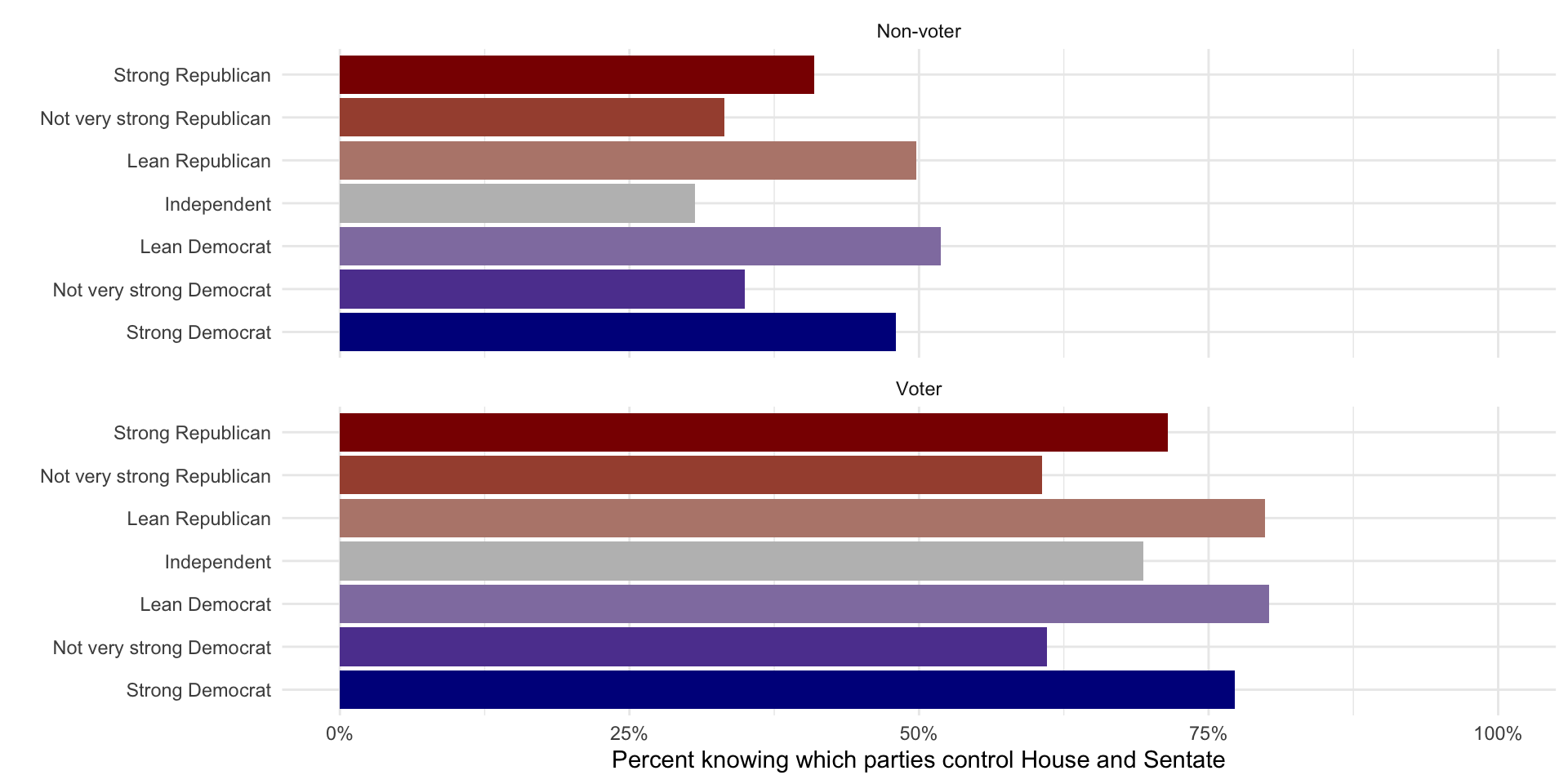

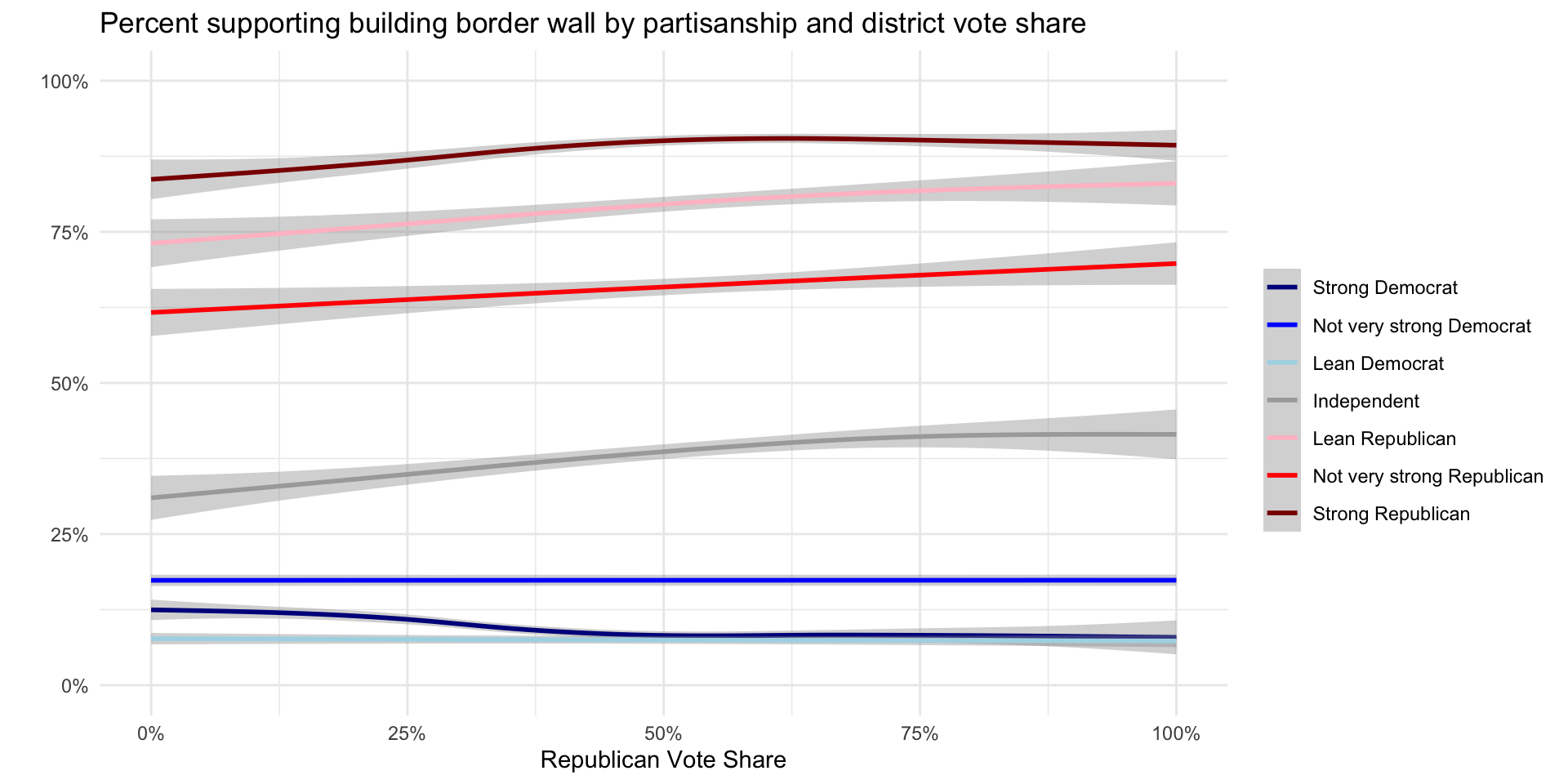
Friday
Plan
What is affective polarization (Iyengar et al. 2019)
- How has it changed?
- What causes it to change?
- (Mis)estimating Affective Polarization (Druckman et al. 2022)
Review for term paper
Attendance Survey!
Click here to be rewarded for your attendance on a beautiful Friday afternoon
Course Feedback
How are we feeling?

You vs Your Peers

You vs Me


What we like so far
The slides and lectures
The readings and concepts
Learning how to analyze empirical papers
Group projects
Class discussion and small group discussion
What we haven’t like so far
The slides, lectures, and class structure
The readings and concepts
Learning how to analyze empirical papers
Group projects
Class discussion and small group discussion
In your words
What I’ll Do:
Starting next week, post periodic guides to general skills in the course
Bring in current events and more applications
- Mondays more of a broader focus on week’s topic / current events / campaigns and elections
Post 1-2 page guides the weekend before a week’s readings
Stay on task/syllabus.
Limit to two “academic” readings a week.
Will send out revised syllabus and course structure on Wednesday
May add News article applications…
What Will You Do?

What I hope you’ll do?
Actually do the (reduced) readings and use additional resources (Guides and reflection questions)
Look for opportunities to apply concepts from the course, bring them up in class
Comment on the guides and additional resources
Come to office hours/send emails/communicate
Respect each other and me
Social Identity Theory
Tajfel and Turner (1979) articulate three components of social identity theory:
- Categorization
- People categorize themselves and others based on internal and external criteria
- Identification
- Affinity
- Membership
- Comparison
- We vs I, Us vs Them, In-group vs Out-group
- Tend to maximize similarities with in-groups and differences with out-groups
Intersectionality of Social Identities
The term intersectionality references the critical insight that race, class, gender, sexuality, ethnicity, nation, ability, and age operate not as unitary, mutually exclusive entities, but rather as reciprocally constructing phenomena (Collins 2015)
- Yes, but how do we study identities in an intersectional manner?
Social Identity and Group Interaction Cramer (2004)
When we conceptualize identity on the level of group interaction, we bridge the individual-level psychological nature of identities and the social processes that create them. (p. 53)

Talking About Politics

Talking About Politics

Talking About Politics

Social Identity Theory in Practice
Social identities are:
Socially constructed
Vary in strength and salience
Relational and intersecting
Critiquing Democracy for Realists
Critiquing Democracy for Realists
Huddy’s critiques:
Group politics is not a hollow exercise
Group-related concerns are legitimate and powerful causes for democratic action
Group-identities are not monolithic and vary in strength and effects
Group politics is not a hollow exercise
Men’s shifting positions on abortion confirm Achen and Bartels’s view that partisan loyalties are far more influential than political beliefs and ideology, leading them to conclude that “ even in the context of hot button issues” such as abortion, “ most people make their party choices based on who they are rather than what they think” But this conclusion is difficult to reconcile with the authors’ own evidence that women shifted their partisanship to identify with the party that better matched their views on abortion. This is not hollow tribal politics. (p. 4)
Group-related concerns are legitimate and powerful causes for democratic action
In sum, group-linked economic and status considerations shape partisan political preferences among group members. This process may not conform to the ideals of a fully informed democratic citizenry among whom each issue is considered on its merits, but it does suggest a reason- able basis for the public’s political decision making. Feminist women, African Americans, or Latinos who support the Democratic Party and evangelical Christians who support the Republican Party because they believe it is more likely to serve their collective interests are not entirely wrong in their estimate of which party is better for their group (Layman and Carsey 2002; Wolbrecht 2000). (p. 9)
Group-identities are not monolithic and vary in strength and effects
Levels of identification with politically relevant social groups thus vary among individuals, such that group political influence is far from monolithic. Those most strongly identified with a social group will be most likely to support the party seen to further the group’s interests. This process intensifies when social identities align, leading to an especially strong partisan identity. But there are many people who don’t conform to group dictates, do so weakly, or have cross-cutting social identities. Groups shape partisan loyalties, but with greater nuance than acknowledged by Achen and Bartels. (p. 10)
Critiquing Democracy for Realists
Huddy’s critiques:
Group politics is not a hollow exercise
Group-related concerns are legitimate and powerful causes for democratic action
Group-identities are not monolithic and vary in strength and effects
- How would Achen and Bartels respond?
- What other critiques would we raise?
Parties and Polarization
What’s a political party?
Many definitions of political parties:
Instrumental
Organizational
Coalitional
Instrumental: Parties Exist to Win Electoral Office
Schattschneider (1944): Parties are “first of all an organized attempt to get power”
Schlessinger (1991): “A political party is a group organized to gain control of government in the name of the group by winning election to public office.”
Organizational: PIG-PIE-PO
V.O. Key offers an organizational view of parties highlighting the distinctions between:
- Parties in Government
- Elected officials
- Parties in the Electorate
- People who identify with a party
- Party Organization
- People who work for local, state, and national parties

Organizational view of Parties as Networks

Parties as Enduring Coalitions
“Political parties can be seen as coalitions of elites to capture and use political office. [But] a political party is more than a coalition. A political party is an institutionalized coalition, one that has adopted rules, norms, and procedures.” (Aldrich 1995)

Parties as Coalitions of Policy Demanding Groups
Parties in the United States are best understood as coalitions of interest groups and activists seeking to capture and use government for their particular goals, which range from material self interest to high-minded idealism.
The coalition of policy-demanding groups develops an agenda of mutually acceptable policies, insists on the nomination of candidates with a demonstrated commitment to its program, and works to elect these candidates to office. (Bawn et al. 2012)
Poltical Parties
- Parties are complex.
- Instrumental
- Organizational
- Coalitional
- Group-centric definitions help explain
- Behavior of parties
- Strength of partisanship as a social identity
Partisan Identification
Generally speaking
Do you think of yourself as a…
- Democrat
- Republican
- Independent
- Other
If Democrat/Republican
Would you call yourself a…
- Not very strong Democrat/Republican
- Strong Democrat/Republican
If Independent/Other
Would you consider yourself closer to…
- The Republican Party
- The Democratic Party
- Neither
Independent leaners tend to look a lot like partisans.
Why do we care?
The importance of party identication reects the fact that—unlike particular social identities, which may come and go as electoral forces—partisanship is relevant in nearly all elections. It shapes voting behavior, of course. But beyond that, each party organizes the thinking of its adherents. A party constructs a conceptual viewpoint by which its voters can make sense of the political world. … like particular social identities tied to the special interests of groups, the reach of partisanship is very broad. For the voters who identify with a party, partisanship pulls together conceptually nearly every aspect of electoral politics. (Achen and Bartels 2017)
Partisanship and the American Voter
Partisanship is an enduring psychological attachment:
Formed early in life
Transmitted via socialization
Acts as a screen perceptual screen
Shapes policy beliefs and vote choice

Partisanship and the American Voter
Partisanship was conceptualized as a psychological identification with a party…. , partisans are partisan because they think they are partisan. They are not necessarily partisan because they vote like a partisan, or think like a partisan, or register as a partisan, or because someone else thinks they are a partisan. In a strict sense, they are not even partisan because they like one party more than another. Partisanship as party identification is entirely a matter of self-definition” (Campbell et al. 1986)
Partisanship and the American Voter
Are voters “fools” (Key 1966) blindly following partisan attachments
How can we reconcile partisanship with retrospective voting?
Partisanship as a Running Tally
Attempt by Fiorina (1978) to offer a rational explanation for:
Stability of partisanship
Predictive power of partisanship
Conditions in which partisanship might change
Partisanship as a Running Tally
- Individuals begin life as issue voters, but how to process tidal wave of issues?
- Partisanship acts as a running tally, a summary of voter’s retrospective evaluations
- Evidence:
- Simple retrospective evaluations predict partisan identification (voters direct experiences)
- Mediated retrospective evaluations (voters experiences mediated through evaluations)
Evidence of Partisanship as a Social Identity
Green, Palmquist, and Schickler (2002) conceptualize partisanship as a social identity:
The same regardless of how you ask the question
Talked about in terms of groups
Stable over time among individuals
Stable in the aggregate
Stable across contexts (campaigns, state and local)
More engaged with politics
How would we know?
How could we distinguish between partisanship as:
- An enduring psychological attachment
- A running tally of retrospective evaluations
A Model of Partisan Change
yt,i=αi+βiyt−1,i+γiXti+ui
- yt,i = Person i’s partisanship at time t
- αi = Baseline partisanship
- βiyt−1,i = Influence of past partisanship
- γiXti = Influence of other factors
- ui = Random shocks
A Model of Partisan Change
yt,i=αi+βiyt−1,i+γiXti+ui
Key question is about the value of β
Close to 1 -> Retrospective running tally
Close to 0 -> Stable social identity
A Model of Partisan Change

A Model of Partisan Change

Summary
Theory: Partisanship is enduring psychological attachment central to understanding American politics
Revision: Partisanship is a running tally
Synthesis: Partisanship is a social identity
Political Polarization
Political Polarization
Take a moment to write down a definition of partisan polarization
Is your definition about:
- Distance
- Difference
- Overlap/Commonality
- Elites/Mass
If you had to visualize this process, draw an image that illustrates polarization
Polarization in Congress
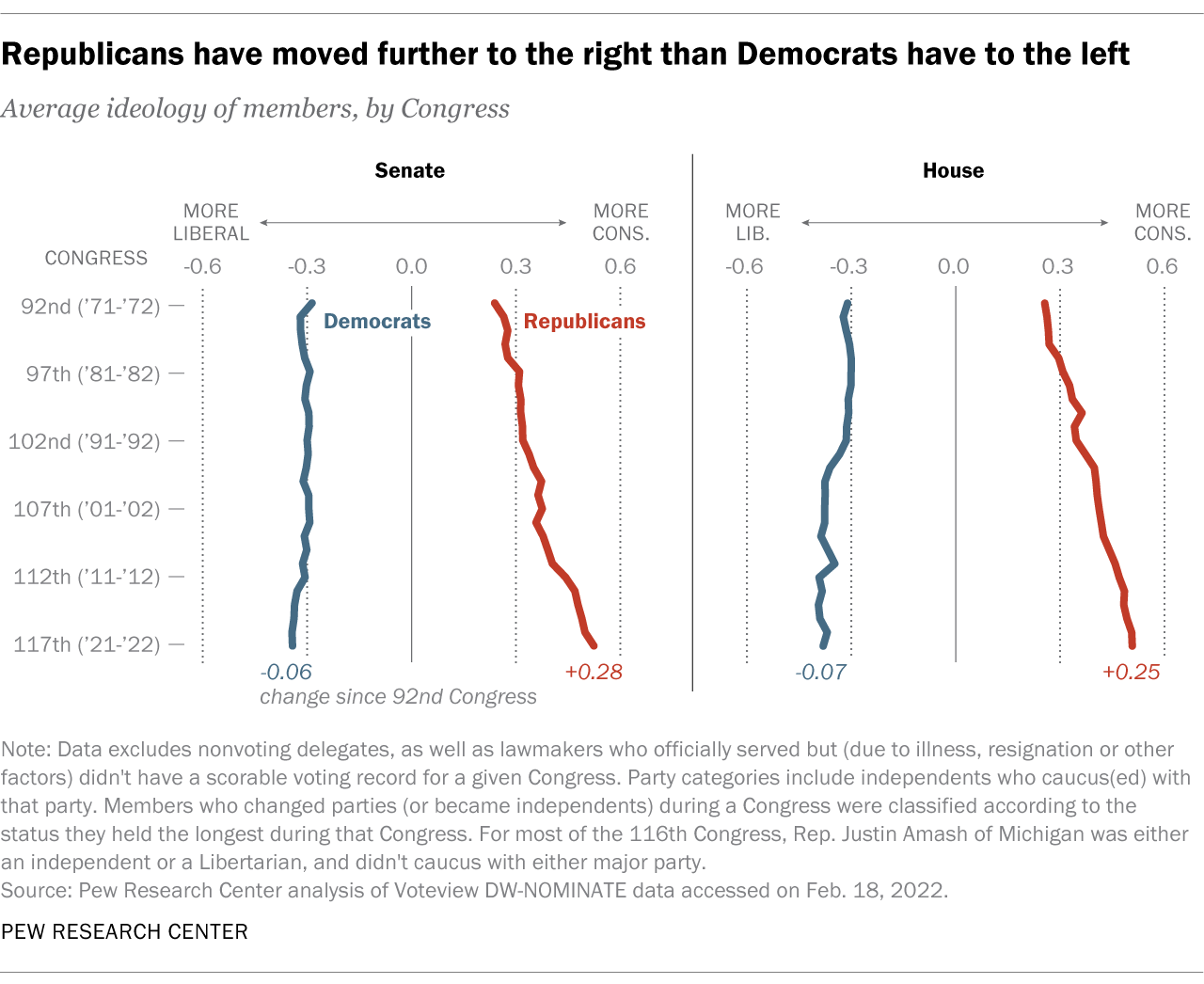
Polarization in The Electorate
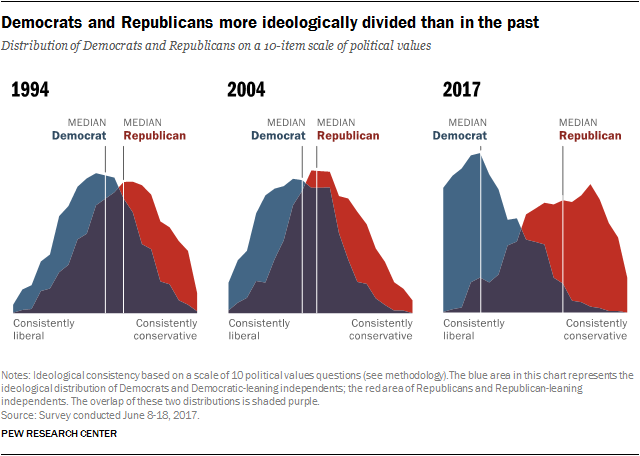
What do we mean by ideological consistency?
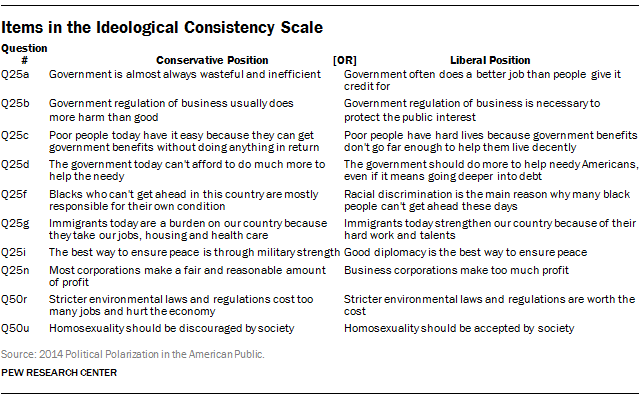
Are we really further apart today than we were in the past?
Consider the following stylized examples
Polarization is about distance and overlap

Polarization as increasing distance between parties

Polarization as increasing consistency within parties

Which world do we live in?

Summary
General consensus that politics has become more polarized at both the elite and mass level
Yet, polarization is a tricky concept and can refer to changes in
- Distance
- Consistency
- Overlap
Affective Polarization
Affective Polarization
Animosity across party lines
“[T]he tendency of ordinary partisans to dislike and distrust those from the other party” (Druckman et al. 2019)
Measuring Affective Polarization
- Survey self reports
- Implicit association tests
- Behavioral games and experiments
Survey self reports
- Feeling Thermometers
- Trait ratings
- Social distance and interaction
Affective Polarization Has Increased Over Time

Affective Polarization
How has affective polarization changed since 2016?
How does affective polarization vary by partisan strenght?
library(tidyverse)
library(haven)
library(ggridges)
load("../files/data/nes_affectivepol.rda")
df %>%
filter(!is.na(affective_polarization)) %>%
ggplot(aes(year, ft_in_party, col = "In Party"))+
stat_summary()+
stat_summary(aes(y=ft_out_party, col = "Out Party"))+
stat_summary(aes(y=affective_polarization, col = "Affective Polarization"))+
theme_minimal()+
labs(col ="",
y= "Feeling Thermometer Ratitings",
x= "Year") -> fig_ap1
fig_ap1 +
facet_wrap(~pid_7pt_f)+
theme(legend.position = "bottom") -> fig_ap2
df %>%
ggplot(aes(x=ft_in_party, factor(year)))+
geom_density_ridges(fill="blue",alpha=.5)+
geom_density_ridges(aes(x=ft_out_party), fill="red", alpha=.5)+
labs(y="",
x = "Feelings toward Out Party (Red) and In Party (Blue)") -> fig_ap3


Implicit Association Tests

Implicit Association Tests Reveal Partisan Bias

Partisan Bias Larger With Explicit Measures

Implicit Partisan Bias May be Larger than Implicit Racial Bias

Affective Polarization Has Behavioral Consequences

Origins of Affective Polarization
Potential causes of affective polarization:
Partisan sorting → reinforcing social identities
High Choice/Polarized Media environment
Political campaigns
Homophily and social networks
However the evidence is often mixed or conflicting reflecting ongoing debates and research
Consequences of Affective Polarization
Iyengar et al. highlight the potential non-political consequences of affective polarization in a number of areas:
- Relationships and social interactions
- Economic decisions
- Medical decisions
Did anything strike you as particularly important, concerning, or questionable?
Druckman et al. (2022)
(Mis)estimating Affective Polarization
Take a few moments to review
- What’s the research question
- What’s the theoretical framework
- What’s the empirical design
- What are the results
- What are the conclusions
What’s the research question
How much of affective polarization is due to misperceptions of the other party’s voters?
What’s the theoretical framework
Druckman et al. are contributing to the broader debate on affective polarization. They make four claims
H1. People overestimate the ideology and political engagement of out-partisans.
H2. Out-party animus will be higher when out-party targets are ideologically extreme
H3. Out-party animus will be higher when out-party targets are more politically engaged
H4. Affective polarization will differ according to whether the out-party targets are ideologically extreme and engaged.
What’s the empirical design
Survey Experimental Design with a 3-wave panel
Outcome: Summary scale of four measures of affective polarization

Experimental Treatment
 ## What are the results
## What are the results
What’s the evidence people:
overestimate the ideological extremity and enagement of outpartisans
this leads to greater out-party animus
which is greater than if folks had more accurate views
People overestimate the ideology and political engagement of out-partisans.
 ## {.smaller} ### Outparty Extremity and Engagement Increases Affective polarization
## {.smaller} ### Outparty Extremity and Engagement Increases Affective polarization

When people think of the out-party, they’re imagining the extremes

What are the conclusions
Affective polarization is an “illusion” in the sense that when people are asked to evaluate a more accurate version of the out party, they do so more positively
The irony seems to be that folk-theory type citizen (engaged, ideological) exacerbates affective polarization.
First Half Review
First Term Paper Structure
- Introduction (1 page)
- Argument (1-3 pages)
- Critique (1-3 pages)
- Response (1-2 pages)
- Conclusion (1 page)
The question of citizen competence
What does democracy require of it’s citizens?
- How you frame this in your introduction will shape the structure of your argument for/or against citizen competence
Arguments for and agaisnt citizen
Think about the topics of the course so far:
- Political Ideology
- Political Knowledge
- Political Cognition
- Retrospective Voting
- Social Identities / Partisanship
Within each topic, you should be able to find evidence that supports you’re general claim, and also consider critiques and responses
Ideology:
Converse shows that most citizens lake coherent, stable belief systems
- For example He finds that …
Ansolabehere, however, contend that much of the instability in ideological beliefs can be explained by measurement error.
- They show that when you …
Freeder et al. however, suggest that Ansolabhere’s approach overstate’s the amount of instability due to classical measurement error.
- Instead they argue ….
General Adivce
Be specific and concrete.
- It’s not enough to summarize Converse. Tell us what evidence is used to support these claims
Cite work supproting your claims (even better page numbers!)
Achen and Bartels’ summary is fine as catch all for some larger literatures we’d didn’t read directly.
MLA/APA/Chicago any style is fine. Just be consistent
Don’t just plug the prompt into ChatGPT
- If it looks like you’re copying and pasting from a LLM, we will have a chat…
References
References

POLS 1140
Social Identity Theory